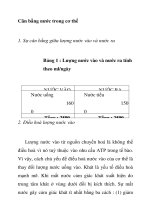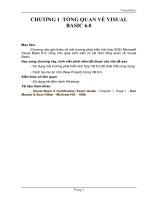Chap007 can
Bạn đang xem bản rút gọn của tài liệu. Xem và tải ngay bản đầy đủ của tài liệu tại đây (519.32 KB, 73 trang )
National Income
Accounting
Chapter 7
© 2003 McGraw-Hill Ryerson Limited.
7-2
Laugher Curve
Three econometricians went out
hunting, and came across a large deer.
The first econometrician fired, but
missed, by a meter to the left.
© 2003 McGraw-Hill Ryerson Limited.
7-3
Laugher Curve
The second econometrician fired, but
also missed, by a meter to the right.
The third econometrician didn't fire, but
shouted in triumph, "We got it! We got
it!"
© 2003 McGraw-Hill Ryerson Limited.
7-4
National Income
Accounting
◆
In the 1930s it was impossible for
macroeconomics to exist in the form we
know it today because many aggregate
concepts had not yet been formulated,
or were lacking rigour.
© 2003 McGraw-Hill Ryerson Limited.
7-5
National Income
Accounting
◆
In the mid-1930s, two Keynesians,
Simon Kuznets and Richard Stone,
began to develop this terminology.
© 2003 McGraw-Hill Ryerson Limited.
7-6
National Income
Accounting
◆
They developed national income
accounting – a set of rules and
definitions for measuring economic
activity in the aggregate economy – that
is, in the economy as a whole.
© 2003 McGraw-Hill Ryerson Limited.
7-7
Measuring Total
Economic Output of
◆ Gross Domestic Product (GDP) is the
Goods and Services
total market value of all final goods and
services produced in an economy in a
one-year period.
◆ It is the single most-used economic
measure.
© 2003 McGraw-Hill Ryerson Limited.
7-8
Measuring Total
Economic Output of
◆ Gross National Product (GNP) is the
Goods and Services
aggregate final output of citizens and
businesses of an economy in one year.
© 2003 McGraw-Hill Ryerson Limited.
7-9
Measuring Total
Economic Output of
◆ GDP measures the economic activity
Goods and Services
that occurs within a country.
◆ GNP measures the economic activity of
the citizens and businesses of a
country.
© 2003 McGraw-Hill Ryerson Limited.
7 - 10
Measuring Total
Economic Output of
◆ Net foreign factor income is added to
Goods and Services
GDP to create the GNP.
● Net
foreign factor income is the
income from foreign domestic factor
sources minus foreign factor incomes
earned domestically.
● In other words, we must add the foreign
income of our citizens and subtract the
income of residents who are not citizens.
© 2003 McGraw-Hill Ryerson Limited.
7 - 11
Calculating GDP
◆
Calculating GDP requires adding
together million of goods and services.
◆
All goods and services produced by an
economy must be weighted, that is,
each good and service must be
multiplied by its price.
© 2003 McGraw-Hill Ryerson Limited.
7 - 12
Calculating GDP
◆
Once quantities of a particular good or
service are multiplied by its price, we
arrive at a value measure of the good or
service.
Finally, all the value measures are added to calculate
that year’s GDP.
◆ GDP is a flow measure (an amount per year).
◆
© 2003 McGraw-Hill Ryerson Limited.
7 - 13
GDP is a Flow Concept
◆
GDP is a measure of final output per
year – it is a flow concept, not a stock
(an amount at a particular moment in
time).
© 2003 McGraw-Hill Ryerson Limited.
7 - 14
GDP is a Flow Concept
The store of wealth, in contrast, is a
stock concept.
◆ The stock equivalent to national income
accounts is the national balance sheet
– a balance sheet of an economy’s
stock of assets and liabilities.
◆
© 2003 McGraw-Hill Ryerson Limited.
7 - 15
Canadian Financial
Flows, Fig. 7-1, p 165
3500000
3000000
D o llars
2500000
2000000
1500000
1000000
500000
0
1959 1962 1965 1968 1971 1974 1977 1980 1983 1986 1989 1992 1995 1998 2001 2004
Years
© 2003 McGraw-Hill Ryerson Limited.
7 - 16
GDP Measures Final
Output
GDP does not measure total
transactions in the economy.
◆ It counts final output but not
intermediate goods.
◆
© 2003 McGraw-Hill Ryerson Limited.
7 - 17
GDP Measures Final
Output
Final output – goods and services
purchased for final use.
◆ Intermediate products are used as
inputs in the production of some other
product.
◆
© 2003 McGraw-Hill Ryerson Limited.
7 - 18
GDP Measures Final
Output
Counting the sale of final goods and
intermediate products would result in
double and triple counting.
◆ If we did not eliminate intermediate
goods, a change in organization—say, a
merger—would look like a change in
output.
◆
© 2003 McGraw-Hill Ryerson Limited.
7 - 19
Two Ways of Eliminating
Intermediate Goods
There are two ways of eliminating
intermediate goods.
◆ The first is to calculate only final sales.
◆
© 2003 McGraw-Hill Ryerson Limited.
7 - 20
Two Ways of Eliminating
Intermediate Goods
◆
A second way is to follow the value
added approach.
● Value
added is the increase in value that a
firm contributes to a product or service.
● It is calculated by subtracting intermediate
goods from the value of its sales.
© 2003 McGraw-Hill Ryerson Limited.
7 - 21
Value Added Approach
Eliminates Double
Counting,Table 7-1, p 166
© 2003 McGraw-Hill Ryerson Limited.
7 - 22
Calculating GDP: Some
Examples
Selling your car to a neighbor does not
add to GDP.
◆ Selling your car to a used car dealer
who sells your car to someone else for
a higher price, does add to GDP.
◆ The value added is the dealer's
services.
◆
© 2003 McGraw-Hill Ryerson Limited.
7 - 23
Calculating GDP: Some
Examples
Selling a stock or bond does not add to
GDP.
◆ The stock broker's commission for the
sales does add to GDP.
◆
© 2003 McGraw-Hill Ryerson Limited.
7 - 24
Calculating GDP: Some
Examples
Pension payments, welfare payments,
employment insurance benefits, and
other government transfer payments
are not included in GDP.
◆ The work of unpaid house spouses
does not appear in GDP calculations.
◆
© 2003 McGraw-Hill Ryerson Limited.
7 - 25
Two Methods of
Calculating GDP
There are two methods of calculating
GDP: the expenditure approach and the
income approach.
◆ This is because of the national income
accounting identity.
◆
© 2003 McGraw-Hill Ryerson Limited.









